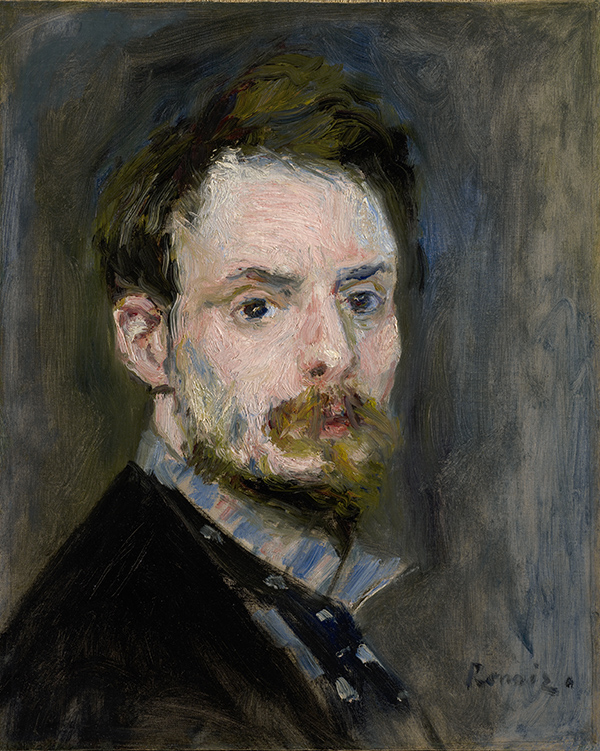Renoir: The Body, The Senses
June 8–September 22, 2019

Pierre-Auguste Renoir
Self-Portrait
c. 1875
Oil on canvas, 15 3/8 × 12 7/16 in.
Clark Art Institute, Williamstown, Massachusetts
Acquired by Sterling and Francine Clark, 1939
Renoir Chronology
1841 – Pierre-Auguste Renoir is born in Limoges, France, on February 25 to Léonard, a tailor, and Marguerite, a dressmaker.
1845 – The Renoir family moves to Paris, in close proximity to the Louvre.
1854 – Renoir enters an apprenticeship painting porcelain for the firm Lévy Frères, where he works for approximately four years.
1860 – On January 24 the Louvre first grants Renoir permission to copy works from the museum’s collection; he creates such studies as Copy after “The Council of the Gods” by Peter Paul Rubens.
1861 –Renoir enters the studio of Charles Gleyre, a Swiss artist who prepares students for entrance to the École des Beaux-Arts. Renoir befriends his fellow students Frédéric Bazille, Claude Monet, and Alfred Sisley. He is admitted to the École the following spring.
1865 – The Salon jury accepts two paintings by Renoir for the first time, a portrait and a landscape. He meets the painter Gustave Courbet, who will become an important influence, and Lise Tréhot, who becomes Renoir’s companion and most prominent model for the next seven years, appearing in such works as Lise with a Parasol.
1866 – Renoir shares a studio with Bazille, who remains Renoir’s frequent studio companion until Bazille’s death in 1870.
1867 – The Salon jury refuses Diana, The Huntress. In response, Renoir and his friends sign a petition demanding a new Salon des Refusés, an exhibition for paintings that were rejected from the Salon.
1869 – Dr. Louis La Caze bequeaths his collection of eighteenth-century French art to the Louvre, including such paintings as Jean-Honoré Fragonard’s The Bathers, which arguably inspired Renoir’s Bathers Playing with a Crab, among others.
1870 – At the annual Salon, Renoir exhibits Bather with a Griffon and Algerian Woman (Odalisque). He also completes A Nymph by a Stream, which formed a pendant with Algerian Woman (Odalisque). Lise Tréhot modeled for all three works.
The Franco-Prussian War begins. In August Renoir is conscripted into the cavalry. He spends four months near Bordeaux but does not enter combat.
1872 – Renoir meets art dealer Paul Durand-Ruel. His relationship with Lise Tréhot ends. He submits Parisian Women in Algerian Dress to the annual Salon, but the jury rejects the work.
1874 – Renoir exhibits seven paintings at the First Impressionist Exhibition, including The Loge.
1876 – At the Second Impressionist Exhibition, Renoir exhibits seventeen paintings and one pastel. The selection includes Study. Torso of a Woman in the Sunlight.
1877 – Renoir exhibits twenty-one paintings at the Third Impressionist Exhibition, including Dance at Moulin de la Galette.
1880 – Renoir meets Aline Charigot, who will become his wife in 1890. She quickly becomes one of his favorite models.
1881 – Renoir travels to Algeria in the spring and spends the autumn and winter in Italy, where he paints Blonde Bather. The following year, Paul Durand-Ruel sends twenty-five Renoir paintings, including Luncheon of the Boating Party, to the Seventh Impressionist Exhibition against the artist’s wishes at a time when he was moving away from the Impressionist circle.
1885 – Renoir and Charigot’s first child, Pierre, is born in March. The family rents a house northwest of Paris for the summer; Paul Cézanne and his family spend a month visiting. Renoir paints Bather Arranging Her Hair.
1887 – Renoir presents five paintings at the Sixth Exposition Internationale at Galerie Georges Petit, publically unveiling The Great Bathers for the first time.
1892 – The French government supports the public purchase of a work by Renoir for the first time, Young Girls at the Piano.
1894 – Renoir meets Ambroise Vollard, who will become his art dealer. Renoir and Charigot celebrate the birth of a second son, Jean. Charigot’s cousin, Gabrielle Renard, moves in with the Renoir family to be their nanny, cook, and caretaker. Gabrielle quickly becomes one of Renoir’s favorite models, appearing in works including Gabrielle with a Rose (La Sicilienne), and she develops a lifelong friendship with Jean.
1898 – Seeking relief from rheumatism, Renoir travels to the south of France. He visits Cagnes-sur-Mer, where he eventually buys a seven-acre farm, Les Collettes, in 1907.
1901 –Renoir and Charigot welcome a third son, Claude.
1907 – Madame Charpentier and Her Children enters the Metropolitan Museum of Art, becoming the first Renoir painting in an American museum.
1913 – Renoir begins working with sculptor Richard Guino, culminating in the Venus Victorious.
1916 – Sterling Clark, founder of the Clark Art Institute, purchases his first painting by Renoir, Young Woman Crocheting. In the thirty-five years that follow, he will acquire thirty-seven more works by the artist, which will become a nucleus of the Clark Art Institute’s collection when the museum opens here in 1955.
1918 – Pablo Picasso obtains his first painting by Renoir. The following year, he acquires Bather Seated in a Landscape, called Eurydice.
1919 – Renoir completes his monumental The Bathers. In September, Renoir begins to plan the donation of paintings to the Musées Nationaux, however nothing is finalized before his death on December 3 in Cagnes-sur-Mer, France, at the age of seventy-eight.
1923 – The Musée du Luxembourg accepts Renoir’s sons’ offer of the 1918–19 The Bathers; their offer of the painting to the Musées Nationaux in December 1922 was rejected because Renoir had been deceased fewer than ten years.
Renoir’s work would continue to enter major museum collections around the world, solidifying his place as a great painter of the nude.